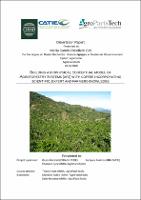Mostrar el registro sencillo del ítem
Bulding a biophysical conceptual model of agroforestry systems (AFS) with coffee incorporating scientific, expert and farmers knowledge
| dc.contributor.author | Rebolledo Cid, María Camila | |
| dc.contributor.author | CATIE – Centro Agronómico Tropical de Investigación y Enseñanza, Turrialba, Costa Rica | |
| dc.contributor.author | Agro Paris Tech, París (Francia). | |
| dc.date.accessioned | 2022-03-01T19:23:51Z | |
| dc.date.available | 2022-03-01T19:23:51Z | |
| dc.date.issued | 2008 | |
| dc.identifier.uri | https://repositorio.catie.ac.cr/handle/11554/11667 | |
| dc.description | 22 páginas : ilustraciones. | es_ES |
| dc.description | Tesis (Mag. Sc. Gestion Ambiental) – CATIE, 2008 | |
| dc.description.abstract | In central America coffee trees are mainly cultivated under shade trees (Hernandez et al., 1997). Coffea arabica originated from Ethiopian highland forests (Huxley and Cannell, 1970), therefore inclusion of shade trees in a plantation may bring beneficial effects. However coffee plants have a big plasticity, and if enough fertilizers are supplied, yields may be substantially increased in full sun (Da Matta, 2004). Farmers from developing countries are concern with increasing revenues. Improving generation of income from coffee is an important criterion. However developing Agroforestry systems (AFS) practices may reduce the productivity of coffee crops, for example decreasing productivity when tree cover is increased above a certain threshold to enhance environmental benefits. On the other hand AFS practices may increase the quality of coffee beans. For example in Nicaragua Vaast et al. (2006) reported that altitude and shade enabled a better growth of coffee cherries resulting in a higher quality of coffee beverage. In order to contribute to maintaining and/or increasing the competitiveness and sustainability of the agricultural sector of Mesoamerica a partnership platform (PCP) was launched in 2007 by CIRAD,CATIE and other 4 research and development regional institutions. One of its objectives is to design, in collaboration with farmers, competitive, sustainable and diversified management strategies for AFS, suitable for particular biophysical as well as economic constraints and opportunities. | es_ES |
| dc.format.extent | 22 páginas | es_ES |
| dc.language.iso | es | es_ES |
| dc.publisher | CATIE | es_ES |
| dc.subject | COFFEA ARABICA | es_ES |
| dc.subject | MODELOS | es_ES |
| dc.subject | CIENTIFICOS | es_ES |
| dc.subject | AGRICULTORES | es_ES |
| dc.subject | PLANTACION | es_ES |
| dc.subject | ARBOLES DE SOMBRA | es_ES |
| dc.subject | SOMBRA | es_ES |
| dc.subject | CONDICION DE LA PLANTA | es_ES |
| dc.subject | CALIDAD DEL PRODUCTO | es_ES |
| dc.subject | PRODUCTIVIDAD | es_ES |
| dc.subject | FACTORES AMBIENTALES | es_ES |
| dc.subject | BIOFISICA | es_ES |
| dc.subject | AGROFORESTERIA | es_ES |
| dc.subject | COSTA RICA | es_ES |
| dc.subject.other | Sede Central | es_ES |
| dc.title | Bulding a biophysical conceptual model of agroforestry systems (AFS) with coffee incorporating scientific, expert and farmers knowledge | es_ES |
| dc.type | Tesis de Maestria | es_ES |
| dc.identifier.status | openAccess | es_ES |
| dc.subject.sdg | ODS 15 - Vida de ecosistemas terrestres | es_ES |
Ficheros en el ítem
Este ítem aparece en la(s) siguiente(s) colección(ones)
-
Publicaciones y documentos [3648]


